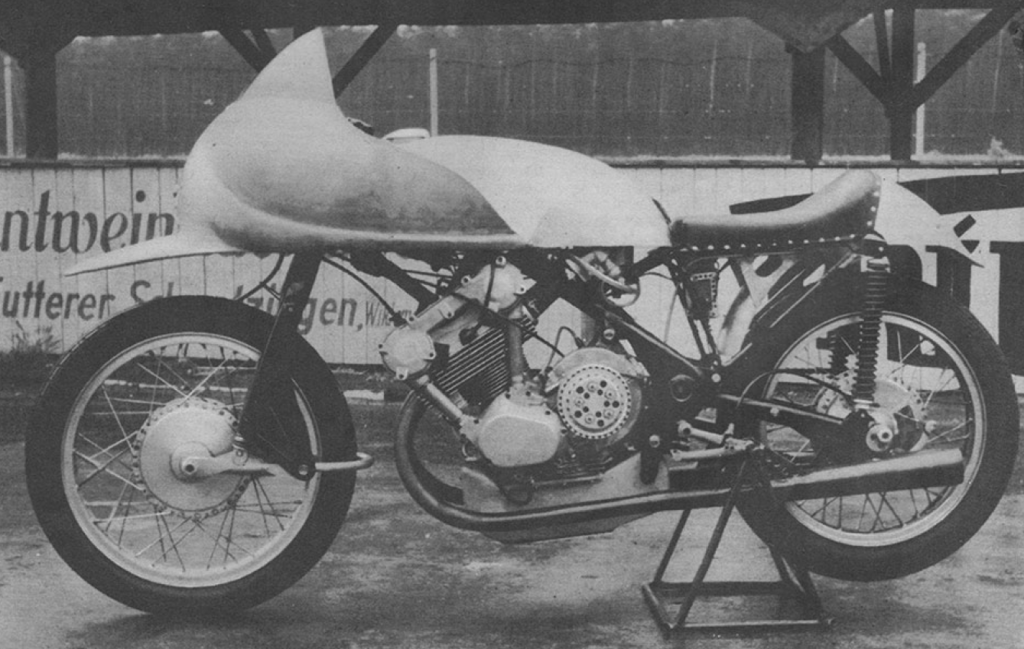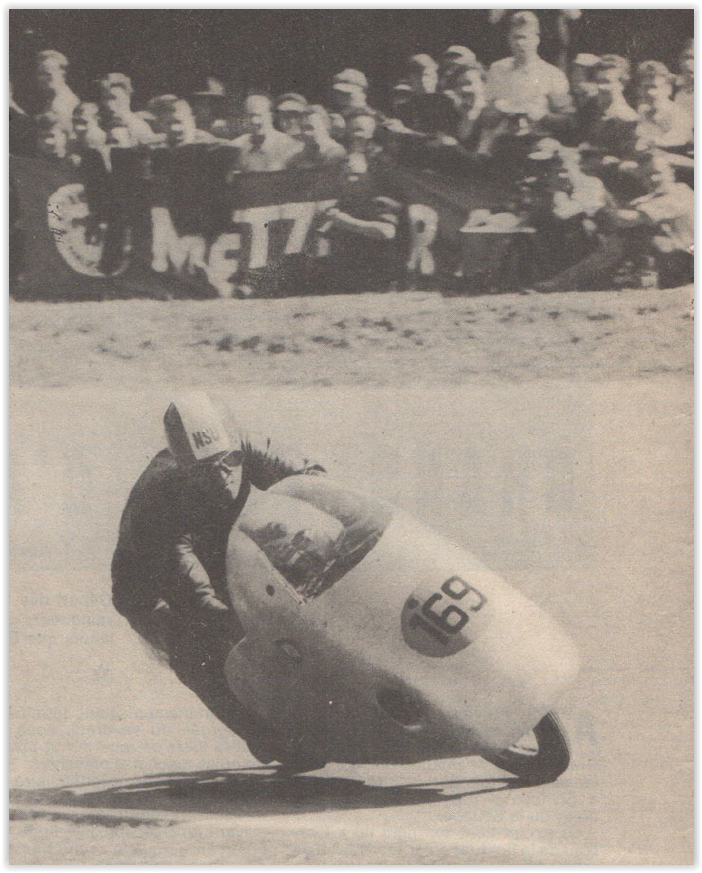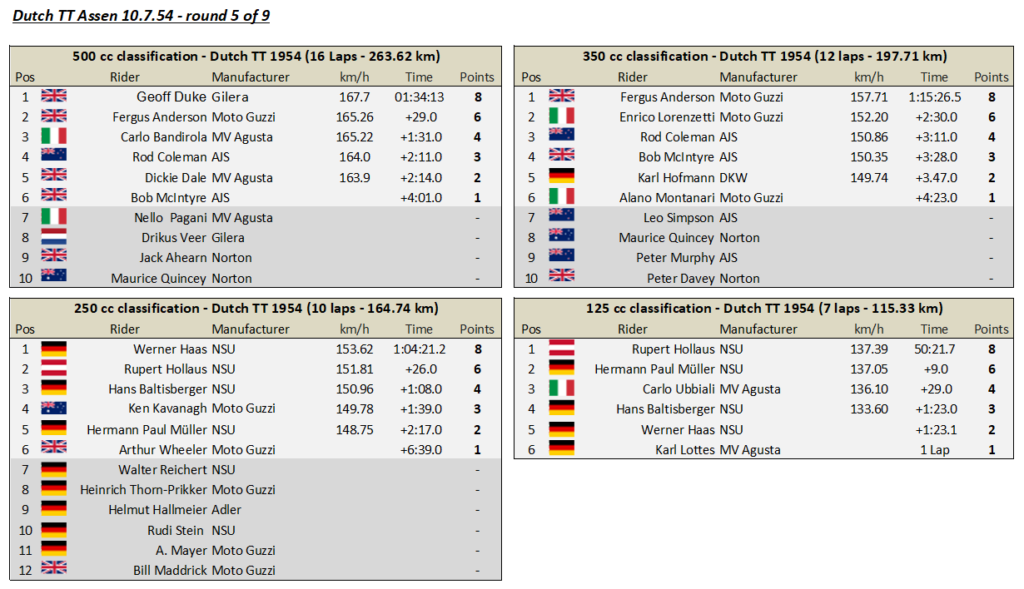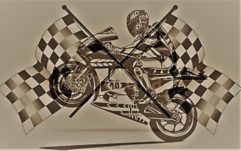
Season continues in Northern Ireland
After the Tourist Trophy, the Italians in particular were challenged as they had suffered serious defeats in all categories. Thanks to superstar Geoff Duke, it didn’t look like a disaster for Gilera at this point in time, only in the premier class up to 500cc. MV Agusta and Moto-Guzzi, on the other hand, had to quickly turn things around at the Ulster Grand Prix if they didn’t want to let NSU win at will. The brands such as Benelli, FB-Mondial, Moto-Morini, Moto-Guzzi and MV Agusta, which had enjoyed success in the first few years without German participation, especially in the smaller categories in the world championship, had already partially withdrawn again, with the exception of the last two mentioned. One of the main reasons for this was the high number of fatalities not only on the race tracks, but also in numerous competitions held on public roads. In Italy, for example, two pilots, Mario Brandolini (on April 3rd) and Ennio Baglioni (on April 4th), had fatal accidents at the Motogiro in April. This 2997 kilometer race had the route Bologna – Rome – Bari – Riccione – Trieste – Milano – Bologna. To the surprise of everyone present at the time, the Guzzi factory team didn’t come at all and thus apparently finally gave up the fight for the 250cc world championship.

The category up to 125cc
Among the spectators at the TT the week before was a Japanese business leader named Soichiro Honda. His friend Kenzo Tada, who was the first Japanese to take part in the TT in 1930, persuaded him to watch this race. This visit should bear fruit in a few years and have a lasting impact on the motorcycle world championship within a short period of time. But let’s now turn to the Ulster Grand Prix of the 125cc, in which an Austrian was supposed to play the main role in 1954. There was a repetition of a tough duel with the two-time world champion (up to 125cc on Mondial in 1951 and 1952), as had already been the case at the Tourist Trophy a few days before. The Ulster Grand Prix, which usually takes place in midsummer, was postponed to the weekend after the TT out of consideration for the teams coming from continental Europe so that they did not have to make the long journey several times.

Tough fight for victory decided by a fall in the rain
Carlo Ubbiali fought against Hollaus again with the knife between his teeth for every meter, but had to pay tribute to his high effort in the sixth lap and fell out due to a fall. The main reason for the Italian’s crash was the rain that had started shortly beforehand. His impact into an embankment looked dramatic, but the all-clear was given at the hospital shortly afterwards and Ubbiali only suffered severe bruises and abrasions. With Hollaus, an Austrian won for the first time, followed by his NSU teammates Hermann Paul Müller, Hans Baltisberger and Werner Haas. Only behind in P5 was the best Italian machine, englishman Cecil Sandford ahead of MV factory colleague Angelo Copeta. With the maximum points of 16 after the first third of the season, Hollaus led Baltisberger (7), Müller, Ubbiali and Sandford (6 each) and Werner Haas with 3 points.

The hat trick of the high flyer and reigning world champion up to 250cc
While NSU factory teammate Hollaus triumphed in the 125cc, Werner Haas achieved this honor in the 250cc machines. In addition to the trophy, the Swabian who lives in Augsburg also deserved a medal for bravery. He had a bad fall in training and sustained a head injury, but still competed in both categories. In the end he didn’t regret it and achieved the triple in the quarter liter class for the first time in Motorcycle Grand Prix history. Before that, the German had to fight to the death with his compatriot Baltisberger and the other NSU factory team colleagues Armstrong and Hollaus. However, the latter two were unlucky when they had to give up due to technical problems with the otherwise reliable machine from Neckarsulm, north of Heilbronn in Baden-Württemberg. Nevertheless, the ailing Haas had to fight hard until the checkered flag to just keep Baltisberger under control. Behind them, “HaPe” Müller completed the podium for NSU. On a private Guzzi, the Englishman Wheeler came third (one lap behind) ahead of his compatriots Horn and Geeson.

Bad end to the weekend in Northern Ireland
After the race started very late and was reduced from the original 27 to 15 laps, it should have already been clear that this halving would no longer allow world championship points to be awarded. In Geoff Duke’s absence, Norton ace Ray Amm won ahead of Coleman (AJS), Laing, Quincey, young Surtees and Ahearn (all Norton). But as many astute observers, including one of the French reporters, suspected early on, this did not count as a Grand Prix victory and therefore this race will not be discussed in detail here. The run up to 350cc did not take place until the following day.

The 350cc class race
As was the case at the Tourist Trophy in the premier class race, which was canceled after 4 laps, fog was the cause of a lot of unnecessary stress for the pilots. Like a week ago at the TT in the 500s, this was once again the big hour for Ray Amm. The Rhodesian was initially only in P6 behind Surtees, Mc Intyre, Farrant, Quincey and Laing. But Surtees, who was initially leading, had to go into the pits to refuel and thus lost a lot of time. Coleman gave up early due to a cold and Amm had caught Laing in the meantime. In poor weather conditions and the onset of rain, it was once again Amm who fought his way forward and took the lead with ten laps to go. Farrant fell a little later and injured his knee, while Brett behind Amm, who was also a good rain rider, tried to catch up with the leaders. The Englishman had meanwhile worked his way up to P2 and was only 4 seconds behind the Rhodesian. But Amm was able to push again and didn’t give up until the finish. It was the Norton factory driver’s fourth Grand Prix victory.



Belgian Grand Prix with only 2 solo classes
As was the case last year with Ernie Ring’s fatal crash, a fatality was to overshadow the race in Spa-Francorchamps this time too. As in 1953, in addition to the teams, only the two larger classes were held in Belgium. Due to the high average speed of these motorcycles, which can now reach well over 200 km/h, it would have been better to go the other way around and organize the smaller categories. The FIM, as the highest motorsport authority, would have been responsible for this. However, their organs have apparently always not cared about the health of the drivers, as would unfortunately be observed again and again in later years and decades. What made matters worse this time was that rain made the weekend an even more dangerous event. Last year, the pilots of the largest classes had suggested a waiver in similar conditions at the Schottenring and were heard, after which the races up to 350 and 500cc lost their world championship status, but were held.


Decision overshadowed by tragedy up to 350 cm³
There were 27 drivers at the start and the DKW factory drivers got off to the best start, with Wunsch being the first to turn into the infamous Eau Rouge about a hundred meters before Hobl. Behind them Ken Kavanagh, Amm, Anderson and Laing. However, it didn’t take long until Kavanagh took the lead on the first lap and shortly afterwards was overtaken by Amm in front of “la Source”, which took the latter into the lead. The Canadian Godwin fell and suffered a fractured pelvis. Kavanagh caught Amm a little later and Lorenzetti had now moved up to P3. A little later, Fergus Anderson drove to his pits with smeared lenses to clean his racing goggles and reported on the serious fall of Laing, who had just been in front of him, before he continued driving. Ray Amm dropped out shortly before the end of the sixth lap. Kavanagh then took home a comfortable win, while Anderson fought his way back to the front and was waved off in second place ahead of Siegfried Wünsche. The German had previously grabbed Lorenzetti. Shortly before the end, August Hobl dropped out with a top result in sight and the DKW factory team missed out on even being able to celebrate two of their drivers in the points.

The next victim of the extremely dangerous course in Belgium
This time it hit Gordon Laing, who was relegated to 6th place in the Senior TT and was third in the non-ranked Ulster GP race up to 500cc, and in the 350cc race he narrowly missed the podium with 4th place. The Australian from Melbourne, often called “Manxie” by his friends, was only 25 years old. Gordon had just joined the Norton team two weeks ago and made his debut as a works driver at the Ulster Grand Prix in Dundrod. In the Spa race he had tried to stay in P3 with Ray Amm, who was fighting for the lead with Kavanagh. Laing crashed in the La Carriére corner on the second lap and suffered serious head injuries. He was killed on the spot. Fergus Anderson, who was driving behind the Aussie at the time of his crash, lost five positions in the pits to report the misfortune to the marshals. He even won the 350cc Dutch GP the next weekend.

The premier class race in Spa-Francorchamps
The Italian Milani was unable to take part in test drives in Monza for Gilera due to injuries sustained in a fall. He was replaced by the Frenchman Pierre Monneret, who, however, did not reach the finish due to a fall. MV Agusta was once again conspicuous by his absence, as was the German BMW works driver Zeller. After the start, Coleman took the lead first, followed by Simpson, Kavanagh and behind them the top favorite Duke. However, the latter was already in the lead at the end of the first lap. At this point, Anderson was only in P11 and Lorenzetti was even second to last. The road was dry and in addition to Lorenzetti, who was getting slower, the German Bartl and his BMW also gave up the race with technical problems. But this would only be the beginning of an impressively high number of failures.

Numerous failures characterized the 500cc Belgian GP
After Amm had just worked his way past Kiwi Coleman when he dropped out on the fifth lap. The same fate befell the German Braun on his Horex, as well as Simpson (AJS), Quincey and Storr (both Norton). After Amm had just worked his way past Coleman when he dropped out on the fifth lap. The same fate befell the German Braun on his Horex, as well as Simpson (AJS), Quincey and Storr (both Norton). Duke ultimately proved with his win that he was hard to beat this season and Kavanagh took the iron out of the fire for Guzzi ahead of Martin on another Gilera. With a new record lap and an average speed of over 180 km/h, Geoff Duke emphasized that Spa-Francorchamps was actually too fast and dangerous for the larger classes, but as is so often the case, no one learned from it and things were to continue like this afterwards.


World Championship round 5 with the Dutch TT in Assen
For the German pilots and factories, the lap in the Netherlands was something like a dress rehearsal for the following German Grand Prix with the return to the Solitude. With three victories in the first three races, the reigning world champion Haas could already secure the defense of his title up to 250cc should he win. For shooting star Rupert Hollaus, who had already won twice in the first two rounds, this was not yet the case in the third of six races. However, if the Austrian won, there would be a chance at NSU’s home race. It would be another 17 years before there would be a world championship race in his home country for the first time. In the Netherlands, on the other hand, races were held very early on and, as the following overview shows, the “Circuit van Drenthe” took place for the last time in 1954. The following year the earliest version of the Assen course, which still exists in a modified form, would be used for the first time.


The Austrian’s incredible hat trick up to 125cc
Apparently there was no match for the young Rupert Hollaus this season and apart from his own teammates, he didn’t seem to have to fear any opponents. Although the MV Agusta 125 was also very fast, the Austrian was able to beat the fastest Italian on this machine twice in a row with the NSU Rennfox. In Ulster, Ubbiali even took off in pursuit of Rupert and in Assen he also lost, but this time to two NSU pilots. With H.P. Müller this time, was a teammate who was able to put Hollaus under the most pressure. The old master was initially in P5 behind Sandford (MV), Hollaus and Ubbiali, who were leading at the start, when the Austrian had already taken over the lead after the first lap. One lap later, H.P. Müller was already in third position and on lap three he appeared in P2 behind Hollaus. Ubbiali had settled in behind and Sandford, in fourth place, fought a tough battle for fourth position with their other teammate until the two combatants retired together. This meant that Baltisberger inherited fourth place ahead of Haas and once again all four NSU factory drivers scored points after the Ulster GP, while their compatriot Lottes also secured one last point behind him in the private MV with P6. Hollaus had thus achieved the triple and with a victory in the following German Grand Prix he would be prematurely relegated as world champion.

The world championship decision in the 250cc race
For defending champion Werner Haas, in the category he dominated this season, things went almost the same as for World Cup leader Hollaus in the 125s. The main difference was that the fast Swabian already had three wins under his belt when he arrived in the Netherlands. This was because his category was already on the calendar in France and he had won everything from there. NSU brought new casing with optimized aerodynamics for its pilots and after the Tourist Trophy, the Moto-Guzzi factory team was back in the game for the first time. However, only Haas started with the new development because it was apparently intended to help him secure a slight lead over his teammates. The favorite for this race took the lead immediately after the start, followed by Hollaus and behind him Kavanagh on the Guzzi fought with another NSU man Baltisberger. Halfway through the race, Lorenzetti, the second Guzzi factory driver, had to give up the race. In third place, Hans Baltisberger from Betzingen near Reutlingen (around 40 km south of Stuttgart) ensured that, alongside the winner Haas, two Swabians stood on the podium with him. With Rupert Hollaus next to him, everyone on the podium spoke German and H.P. With P4 behind Ken Kavanagh on the Moto-Guzzi, Müller ensured that four NSU factory pilots again ended up in the points.

Moto-Guzzi double victory in the 350s
A total of 40 drivers lined up at the start before the 12 laps began, including 11 factory drivers. As before in Belgium, the two-stroke three-cylinder factory DKW got off to a good start using the push start that was common at the time. But August Hobl, who was leading at the start, was intercepted by Guzzi factory driver Anderson on the first lap. Lorenzetti also caught the fast German from Frankfurt am Main, followed by Montanari and Amm. On lap three, Lorenzetti was in Position 2, 34 seconds behind leader Anderson. Montanari fell back shortly afterwards and Hobl, who was then in 4th position, unfortunately did not see the checkered flag. But his DKW teammate Hofmann came third behind Coleman and his AJS factory mate Mc Intyre ahead of Montanari in fifth place. Ray Amm, on the other hand, had bad luck with the crash and then gave up. In the World Championship, Guzzi ace Anderson now leads with 14 points ahead of Coleman (12), Lorenzetti (9) and Amm with 8.

Favorite victory in the premier class
Superstar Geoff Duke was usually unbeatable on the four-cylinder Gilera, as long as there were no technical problems and the weather didn’t go crazy like at this year’s TT. In such cases, the intelligent man preferred to settle for a podium place rather than unnecessarily risk his life. That’s precisely why the four-time world champion, who had won two titles each in the 350 and 500cc classes, would ultimately be over 92 years old. This time, with the exception of BMW, all the factory teams were at the start again when the 37 drivers took part in the 16 laps. It was the New Zealander Coleman who got away best on his AJS, but behind him was Duke, who didn’t hesitate for long and took the lead on the first lap. Behind them were Anderson, Amm, Dale, Bandirola and only then the initial leader Coleman. Unlucky Ken Kavanagh was already well behind and gave up after two falls. Mc Intyre, Simpson, Armstrong, Montanari, local hero Veer and Pagani were now behind the leading group when Simspon had to stop to adjust his clutch. By the tenth lap, Duke was leading Ray Amm, Bandirola and Anderson. However, the latter continued to work his way forward, but was unable to catch up with the leading man. Simpson was already well behind when he risked too much to catch up and fell and had to retire uninjured. Duke won safely and also set a new record lap with an average of 169.761 km/h.


Before the German Grand Prix of 1954
Werner Haas was already confirmed as world champion and with a victory on the Solitude, Hollaus could become his successor in the category up to 125cc. In the larger two classes, however, the situation in the World Championship was still completely open before the return to Solitude after a failed interim year at the Schottenring. A French journalist took the trouble to summarize the situation after the Dutch Grand Prix in Assen. He also congratulated the newly crowned 250cc double world champion and successful defending champion Haas. He also pointed out that Amm (hence the rating listed twice with the uncorrected version first) lost his 8 points from the Ulster Grand Prix. This is for the reason that he had already foreseen very well shortly after the race there, because the 500cc race was held over a distance that was too short after it was canceled due to poor conditions. The only embarrassing thing is that the FIM didn’t have its own regulations in mind at the time when it first published an incorrect interim ranking. But luckily there were attentive journalists who wore their heads on their shoulders for more than just washing their hair. At this point I would like to thank the writer at the time, also because he was often the only one to publish complete lists of results, while almost everyone else only concentrated on the top five or six. As a result, not even the official MotoGP website has such a complete overview of results from previous years, while we can now provide this.

Unless otherwise stated, this applies to all images (© MotoGP).

No Comments Yet